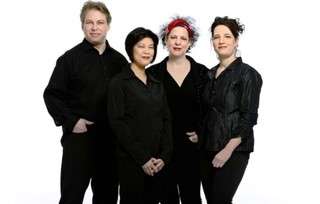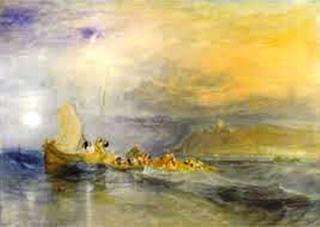|
Back
Beatific Brownian Movements New York
Mary Flagler Cary Hall, DiMenna Centre
08/14/2018 - August 15,16,17,18,2018
“TIME:SPANS”:
Cassandra Miller: About Bach
Linda Caitlin Smith: String Quartet III: Folkestone
Bozzini Quartet: Clemens Merkel, Alissa Cheung (Violins), Stéphanie Bozzini (Viola), Isabelle Bozzini (Cello)

Bozzini Quartet (© Michael Slobodian)
“The end is in the beginning, and yet you go on.”
Samuel Beckett, Endgame
A few semi-troglodytes like this writer feel a certain trepidation when hearing about a whole week of music by the Earle Brown Charitable Foundation, obviously in homage to the composer. It isn’t that I dislike the music–like that of his colleagues Christian Wolff and Morton Feldman, Brown’s music has moments of sheer beauty and the most delicate measures. Yet still, one is always prompted to “appreciate” his “Free form”, his particular notation, the dislocation of “pure control” and “pure indeterminacy”, of music that can be played upside-down or backwards or “explicit” or “implicit”.
When I eat a delicious cake, I don’t want the baker telling me that I don’t really appreciate the cake because I don’t understand the algorithms which went into its making.
Nonetheless, the Earle Brown Charitable Foundation found a full house last night in the DiMenna Center. Perhaps they weren’t all acolytes, they wanted to know more. Like me, they were conscious of the trend which blossomed some six decades ago, faded to a degeree and has reflections in the musical currents of today.

C. Miller/L. C. Smith (© ISCM.org/Kalvos.org)
That initial trepidation was hardly necessary. Cassandra Miller and Linda Caitlin Smith offered a pair of 30-minute works for string quartet, played by the faultless Bozzini Quartet, who frequently work with these artists. Neither piece zipped along in classical sonata form, nor did they offer a litany of melodies and complex harmonies. Instead two different works, possessing their own logic (and frequently Earle Brownian motion) had studies which became slowly emotionally overwhelming.
Cassandra Miller’s About Bach was as far from Bach as possible. In theory, she started with the first phrase from Bach’s Chaconne from the Second Partita. But the quartet’s harmonies were not only far from Johann Sebastian, they were probably out of his infinite imagination.
Within a few measures, the Bozzini Quartet stopped playing for a few seconds, then continued onto another section. A few measures later, they started another section. And so on, etcetera for perhaps three-dozen short sections, anywhere from 20 to 30 sections long.
The music was initially wheezy. No vibrato from any of the instruments. It could have come from a 13th Century church organ, or an accordion. Yet I, for one, was fascinated not where it was going–for it didn’t seem to be going anywhere–but how each stasis had its own character, in fact its own historical period.
At times, Ms. Miller offered music without weight, airy, floating above the auditorium. At times, she reverted to 14th Century organum Music Antiqua.
A few sections were purely gorgeous. A melody played by viola, reflected softly by the same melody a muted violin, with pizzicati–two or three notes–plucked by cello and second violin.
During another section, the dissonant harmonies–again with no vibrato, with no counterpoint–became totally diatonic in simple major chords. It was as if, in a cavern of Sixth Century B.C Greek oracles, a 19th Century gentleman in dinner suit entered, sat down for a few seconds and then quietly departed.
At the end, one felt neither Bach nor Earle Brown style music, but a litany in an archaic language casually sung, casually satisfying.

J. M. W. Turner’s Folkestone
Linda Caitlin Smith’s Folkestone was not literally about the series of paintings by the mid-19th Century painter J.M.W. Turner, but the influence was in the title...and yes, the music.
Ms. Smith had found a sketchbook of Turner, where he had returned day after day to the same site at Folkestone, England, painting the same work with the same perspective, yet seeing it with different eyes.
The composer thus took 25 “views” of the same music, and, like About Bach, offered short sections, each about one minute long.
One fundamental difference. Her original selection was not a few measures of Bach: it was a complete, quite amiable imitation of an old Celtic folk song. (The composer was not in the auditorium, so I don’t know whether it was original or not.) This folk song was then repeated 25 times. Not with variations per se, but with different intonations on the strings.
It as if she had drawn a quadrangular cube on a computer screen, and then turned it in 25 different directions. The cube was always apparent, but the lines were attempting to break free, inner chords were doubling in harmonies or tempos, while the outer lines remained motionless. We heard quiet strumming, measures of the original song floating and coming back...
And over it all, one of the two violins playing a soft haunting never-moving high-register note. (The closest I could think of was Smetana’s persistent high note in a string quartet, but that was to indicate his coming deafness.)
At the end, Ms. Smith had not physically broken up her Folkestone theme, but the effect was a change from song to notes to molecules. Yet still retaining that first mesmeric folk-tune.
A miracle of sorts, I guess. As was the whole opening evening of “TIME:SPANS”.
CODA: The Earle Brown homage continues tonight through Saturday at 8pm at DiMenna Center, with orchestras, chamber groups (like JACK and Alarm Will Sound) and soloists. If last night’s concert was any indication, the music should be surprising, inventive and quietly mind-shattering.Well worth attending.
Harry Rolnick
|